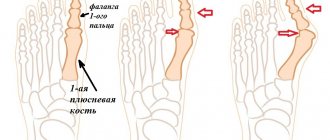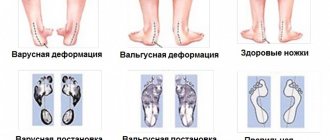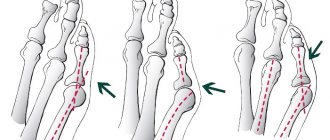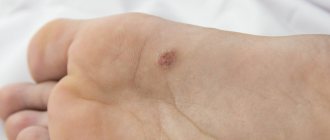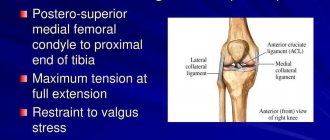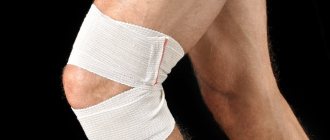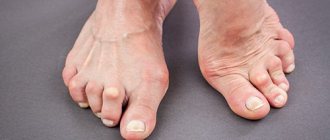Both young and elderly people come to see an orthopedist with complaints that their ankle hurts. Of course, the reasons for the appearance of unpleasant sensations are different, but most of the symptoms are similar.
The ankle is the narrowest place on the leg in the area where the lower leg meets the ankle joint. The heads of the tibia and fibula are located here; numerous tendons of the flexor and extensor muscles of the foot are attached to them. Large blood vessels, the tibial and peroneal branches of the sciatic nerve pass here.
Ankle pain can be caused by pathologies of the musculoskeletal system, autonomic nervous system, blood vessels, soft tissues, etc. The main factors in the manifestation of an unpleasant reaction can be inflammation, infection, trauma, the development of a neoplasm, deformation of bone and tendon tissue, etc. We will talk in detail about all the probable causes of pain in the ankle area in the material we bring to your attention. Here you can find out which doctor you should contact in a particular situation, what additional symptoms to look out for when assessing your condition. It tells you how to provide yourself with first aid measures in case of injury to this area of the lower limb.
If you are in Moscow and are worried about pain in the ankle area, you can make an appointment for a free appointment with an orthopedist at our manual therapy clinic. Experienced doctors work here. They will be able to make an accurate diagnosis and give directions for additional examinations. You will be offered an individual course of treatment without surgery or the use of pharmacological drugs. You can sign up using the special form located at the bottom of this page. You can also call the clinic administrator at the specified phone number.
Legs hurt and ankles are swollen
Very often, patients have pain in their legs and swollen ankles on both limbs at once. This symptom may indicate the development of a systemic inflammatory process or symmetrical destruction of the ankle joints. Most often, patients complain that the leg hurts and the ankle is swollen on only one limb.
It is worth understanding the basic principle of primary differential diagnosis. If the process affects the joints on both legs symmetrically, then first of all the possibility of developing rheumatoid processes should be excluded. This may be the articular form of ankylosing spondylitis, rheumatoid polyarthritis, systemic lupus erythematosus, psoriatic arthritis, gout, etc. In case of unilateral damage to the ankle joint, the possibility of aseptic inflammation, diastasis of the lower leg and damage to the tendon or ligament apparatus should be excluded.
Any inflammation produces pronounced swelling due to stagnation of lymphatic fluid and increased processes of capillary blood supply to the pathologically altered tissue area. But pain and swelling can also have a traumatic etiology. If there is a partial rupture of soft tissues (muscles, ligaments and tendons), then slight capillary bleeding will occur at the lesion site. The accumulated blood itself creates the preconditions for an increase in volume and provokes the subsequent process of inflammation in order to eliminate the accumulated formed blood particles that undergo decay.
An experienced orthopedist will be able to conduct a thorough differential diagnosis of such conditions. But, if there was a traumatic impact (bruise, twisted leg, fall from a height, unsuccessful landing from a jump, etc.), then you must first contact a traumatologist. This doctor will be able to exclude the possibility of a fracture, bone crack, sprain and rupture of ligaments and tendons, and dislocation. To do this, he will order an x-ray and conduct a series of diagnostic functional tests. After an injury, a full course of rehabilitation should be carried out using manual therapy methods. If this is not done, then cicatricial deformations of the ligaments and tendons will lead to the fact that with the next traumatic injury the volume of damage will be much greater, up to a complete rupture of the ligamentous and tendon apparatus of the ankle joint.
Next, we will consider the main causes of pain and swelling in the ankle.
What to do if you twist your ankle and it's swollen?
With bruises, sprains, and sometimes fractures, severe pain and swelling sometimes do not appear immediately, but only several hours or even days after the injury. Because of this, patients often do not associate the onset of acute pain with a minor injury that occurred a few days ago. If the ankle is swollen on the outside, there are scratches or bruises, then the pain is almost always caused by the injury. For various injuries to bones and joints, the help of a doctor is required, an x-ray examination is required. Before going to a medical facility, self-help to alleviate the condition is acceptable. What to do if your leg is swollen after a bruised ankle:
- remove shoes and socks;
- apply ice to the affected area;
- provide rest to the leg;
- take a painkiller.
You should not touch, squeeze, or try to “straighten” the affected joint yourself. All manipulations - from a pressure bandage to the application of a plaster - can only be performed by a doctor who has examined the x-rays.
Reasons why legs hurt in the ankle area
The reasons why your feet and ankles hurt can vary. Depending on the patient’s age, certain risk factors may come to the fore. At a young age, these are most often injuries and their negative consequences:
- sprains of ligaments and tendons;
- rupture of the ligamentous and tendon apparatus;
- cicatricial deformation of ligamentous and tendon tissue with loss of its physiological properties;
- calcification of soft tissues around the ankle joint;
- diastasis of the tibia and fibula after rupture of ligament and tendon tissue;
- fractures and cracks of the tibia, fibula, calcaneus or talus;
- dislocations and subluxations, after which deformation of the joint capsule begins and joint mobility is limited;
- contractures and ankylosis.
At a more mature age, pathologies associated with excess body weight, metabolic disorders, smoking and drinking alcoholic beverages come to the fore. All this significantly impairs the blood supply to the tissues in the ankle area and various degenerative dystrophic diseases develop.
Why does the leg hurt in the ankle area most often between the ages of 30 and 45?
- The cartilage tissue in the ankle joint is affected and the first stage of deforming osteoarthritis develops;
- the articular form of ankylosing spondylitis begins;
- uric acid crystals are deposited around the joint and irritate the surrounding soft tissue;
- incorrect foot placement develops in the form of flat feet or clubfoot against the background of constant neglect of the rules for choosing shoes for constant wear and sports;
- Vascular problems arise (obliterating endarteritis, atherosclerosis, diabetic angiopathy, varicose veins of the lower extremities, etc.).
At an older age, osteoporosis, osteomalacia, and deforming osteoarthritis, including those affecting the knee joint, are common causes of pain in the ankles. It is important to promptly exclude malignant neoplasms affecting bone tissue. At an early stage, they respond well to treatment.
At any age, pain in the ankle area can be caused by various pathologies of the autonomic nervous system. The most common disease of this type is osteochondrosis of the lumbosacral spine. Pain can also be caused by its frequent complications, such as intervertebral hernia, protrusion, disc extrusion and herniated sequestration.
Other reasons for pain in the ankles of the feet are excess body weight, valgus deformity of the joint of the first toe, sciatic tunnel syndrome, injuries, etc.
Ankle pain
Pain in the ankles can be caused by various internal diseases, injuries and other factors, which only a doctor can tell you in more detail - self-medication in this situation is extremely unwise. The most likely causes of pain in the ankle area may be:
- osteoarthritis;
- post-traumatic arthritis;
- arthritis;
- ankle injury.
If you promptly seek medical help for ankle pain, you can avoid serious health consequences.
Osteoarthritis
The rapid development of this disease can negatively affect the functioning of the musculoskeletal system. By osteoarthritis, modern medicine refers to a number of diseases affecting both the articular cartilage and the joint itself. And although it is possible and necessary to fight osteoarthritis, many patients remain disabled for the rest of their lives, so it is extremely important not to miss the moment when the disease first made itself felt. Among the main risk factors, the most significant are congenital bone diseases, obesity, acute lack of estrogen, serious joint injuries and others.
Post-traumatic arthritis
As a rule, this complex disease makes itself felt after a leg injury, when there is serious damage to the connective tissue. The development of post-traumatic arthritis is directly influenced by deformation or displacement of the joint. Pain in the ankle area is caused by the replacement of cartilage tissue with connective tissue, which is characterized by reduced elasticity. It is also worth noting that the progression of the disease is constant, so pain can only intensify over time. In addition, there is a possibility that with post-traumatic arthritis, joint mobility will significantly decrease, which leads to partial or complete loss of performance.
Arthritis
This disease is associated with the development of inflammatory processes and various joint pathologies. During the course of arthritis, a distinctive pattern is discovered - the accumulation of exudate directly in the cavity of the affected joint. Typically, pain in the ankle area occurs with any physical activity. The risk group is predominantly dominated by older people, but young people often have to deal with arthritis.
Ankle injury
Damage to the ankle joint may well cause severe pain in the ankle.
This problem is usually encountered by people involved in active sports: football, tennis, basketball, gymnastics. For prevention purposes, it is recommended to use special shoes that will minimize the risk of injury. Author: K.M.N., Academician of the Russian Academy of Medical Sciences M.A. Bobyr
My ankles hurt a lot when I walk
Most often, the ankles of the feet hurt greatly during movements. This is walking, running, jumping. At rest, no unpleasant sensations may appear. Why the ankle hurts when walking can only be said by an experienced doctor, who will rule out the possibility of scarring of the tendon and ligamentous apparatus, and the appearance of signs of the growth of bone growths on the heel and talus bones.
The most likely cause of pain in the ankle when walking is diastasis (divergence) of the heads of the tibia and fibula. This disease occurs due to traumatic damage to ligament and tendon tissue. The discrepancy of the bones leads to deformation of the ankle joint. Gradually, secondary contracture may develop due to the formation of excess scar tissue. In this condition, a person has difficulty moving his foot in different directions. Urgent assistance from an orthopedist is required.
The appearance of pain in the ankle when walking may be a symptom of the development of vascular pathology. This is the so-called intermittent claudication. With it, the patient is forced to periodically stop while walking due to acute pain. After a short rest, the pain goes away, but reappears as you continue to move.
Causes of pain in a bone in the leg
Most chronic foot diseases are caused by mechanical imbalances. The innate position of the bones is designed for their proper use and loading. Diseases, overload, and incorrect shoes adversely affect the position of the foot and lead to pathologies.
Excessive pronation, that is, “rolling” the entire foot inward, overloads the first metatarsophalangeal joint. Over time, a “bone” or “bump” grows there - the body’s attempt to increase the area of contact of the joint with the surface. Pronation also changes the condition of the ankles: the inner ligaments are stretched and the outer ones are compressed.
The appearance of pain in the area of the styloid process of the metatarsal bone along the outer edge of the foot is an indicator of overload of the lower leg muscles. The condition is characteristic of hypopronation or supination - “rolling” the foot outward. If the position of the foot is not corrected in time, the bony protrusion may even come off due to awkward movement or constant microtrauma.
Effective Treatments
The basis for treating problems with protruding bunions is correcting the position of the foot to reduce the load on its individual areas. There are active and passive correction. Active includes improving muscle function through exercises, passive includes any orthopedic devices to change position or eliminate symptoms. According to reviews from patients and clients, the following help best:
- Exercises on a balance pad. Strengthen the muscles of the lower leg and foot, improve blood circulation and tone for any foot problems. An indispensable method of active correction.
- Walking on orthopedic mats. Stimulates the active points of the feet, engages proprioception - the correct sense of the position of body parts.
- Wearing orthopedic insoles. Factory insoles are useful for prevention, and individually made insoles are useful for treatment.
- For pain at the base of the first toe, valgus splints are indispensable, and in the ankles - special ankle braces. For many problems, special products have been developed that are very effective when selected correctly.
- Massagers act directly on pain. Mats and rollers with needles, embossed papillae, and protrusions stimulate mechanoreceptors and block the conduction of pain impulses.
You can solve the problem of pain in the bones at Medtechnika Orthosalon. After consulting your doctor, our consultants will select the most appropriate solution, taking into account the doctor’s recommendations, the characteristics of the problem and the condition of the legs. Each salon has foot analysis equipment and a full range of effective medical products.
With us you can also use the service of individual custom-made insoles:
My leg hurts in the ankle area: what to do?
If your ankle hurts, the first thing to do is consult a doctor. If on the eve of the onset of unpleasant symptoms there was a traumatic impact (fell, sprained an ankle, stumbled, jumped with an unsuccessful landing), then you should immediately contact a traumatologist. This doctor will use an x-ray to eliminate the possibility of fractures and cracks and prescribe effective treatment. If necessary, a plaster cast will be applied to temporarily immobilize the lower limb.
If your leg hurts in the ankle area, but there was no injury, you should limit your mobility and consult an orthopedist as soon as possible. This doctor will conduct a thorough differential diagnosis. If necessary, he may recommend consultation with other specialized specialists (angiosurgeon, phlebologist, neurologist, etc.).
Do not attempt to diagnose and treat yourself. This article is not a comprehensive source of knowledge on this issue. Information provided here is for general information purposes only. You cannot carry out treatment on your own based on the information obtained here. This can lead to disastrous consequences. Carry out treatment only under the supervision of an experienced physician.
Painful ankles: how to treat them
If your legs hurt at the ankles, treatment can begin only after an accurate diagnosis has been made. Pain itself is not a disease. This is a symptom of the disease. Therefore, if your ankles hurt, consult a doctor before treating them. He will prescribe x-rays, ultrasound, MRI, CT and other types of examinations. This will help in making an accurate diagnosis.
If you have pain in your foot in the ankle area, you can visit an orthopedist at our manual therapy clinic completely free of charge. During the initial consultation, the doctor will conduct an examination, collect medical history and make a preliminary diagnosis. You will receive individual recommendations for further examination and treatment.
In our manual therapy clinic, treatment of pathologies in which the leg hurts in the ankle area is carried out using physiotherapy, osteopathy, massage, kinesiotherapy, and therapeutic exercises. If necessary, reflexology, laser exposure and other methods of restoring the integrity of damaged tissues are used. We do not use pharmaceutical drugs or surgery. The course of treatment for each patient is developed individually.
